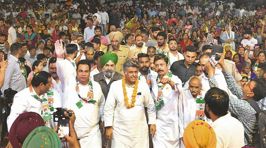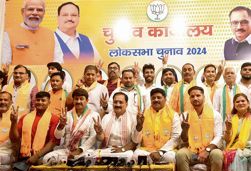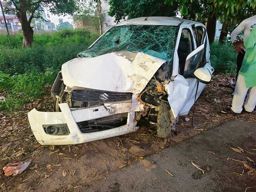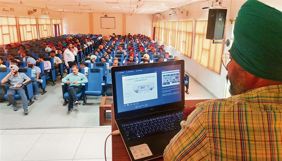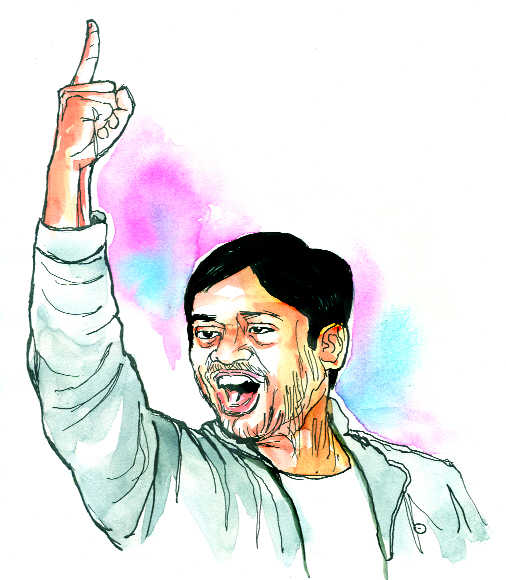
Harish Khare
On Friday morning, everybody was talking about JNU student union president Kanhaiya Kumar's speech on Thursday night after he had been released on bail. One old-timer from Delhi rang up to say that India “now has a new Amar, Akbar, Anthony.” The reference was to Kanhaiya, Umar Khalid and Rohith Vemula. That definitely was some food for thought.
Could anyone have thought, say three months earlier, that eminent columnists, anchors, editorial writers and other professional pundits would be writing about, analysing, praising these three unknown characters? That ministers would find themselves trafficking in half-truths about these boys?
Each of the three has expressed himself in different places, and at different times, but I think what has captured the nation’s imagination is that collectively the three have spoken thoughts which the mainstream thinking dare not think.
They have brought us face to face with issues and ideas the mainstream has contrived to push under the carpet.
Admitted, each society likes to think of itself as a fair, reasonable and just arrangement. We feel uncomfortable with all those who remind us of our imperfections and flaws, those who point out the ugliness at work around us. We call them names: “secular,” “socialist,” “Marxist,” “Naxalite,” “anti-national”; or, simply, “intellectual,” as if to think critically and independently was a crime and a social aberration.
All the attention and admiration this new Amar-Akbar-Anthony trio has hogged reflects poorly on the professional politician, irrespective of his party. The political leaders — ruling or in opposition, national or regional — have lost moral legitimacy to command our respect and deference. This should perhaps be the most unsettling part of the Kanhaiya-Umar-Rohith phenomenon.
Five years ago, the country was in a similar mood of disenchantment and we all flocked with garlands and topis to Anna Hazare’s tent. That movement, as it turned out, got hijacked by political ambition. Then, all the “spiritual leaders” — gurus and babas, who we thought were administering to our troubled souls — turned out to be shrewd businessmen, expanding their mercantile interests. That experiment with Anna Hazare and its political and electoral misuse devalued the ‘politics of good intentions.’ Good, honest citizens across the land felt let down, even cheated.
That is why perhaps in this vacuum we find it refreshing, even invigorating, when a Kanhaiya or Umar Khalid or Rohith Vemula (posthumously) talk of dark realities of caste, class, discrimination, poverty.
Politics lures because it promises to bestow a power to tell the rest of society what to do and how to do. But here was Kanhaiya refusing the temptation: “I am not a politician, I am a student. I have no intention of joining mainstream politics or contesting any election. I want to question as a student.”
Question, yes; quibble, why not; quarrel, certainly. Keep the pot of democratic dissent boiling.
“Is it possible to create modern architecture which has links to tradition in terms of culture and climate and solve our problems of exploding population and development requirements?
This was the central question posed by India’s pre-eminent architect and urban designer, Raj Rewal, when he delivered the first Cyrus Jhabvala Memorial Lecture last month in Delhi. (Full disclosure: Cyrus Jhabvala was my father-in-law).
The answer was indeed ‘yes’ and Rewal Saheb sustained this theme by extensively illustrating from the buildings he has designed for over four decades at home and abroad.
The challenge for any architect in India has been to design a building that will work for us in our mostly hot climate, rather than copy or imitate the western architecture.
It was a pleasure to discover that Raj Rewal had designed the Parliament House Library complex, a place where I have spent countless hours. It is a very aesthetically pleasing building, making full use of sunlight; even the basement reading area is bathed in sunlight on a reasonably good, clear day. The primary challenge also was to have a design that would fuse with the three major existing buildings — the Parliament House itself, the South and North Blocs and the Rashtrapati Bhavan.
As Rewal saw it, the challenge was how to reconcile the architectural legacy of imperial power, as brilliantly conceptualised and executed by Edwin Lutyens and Herbert Baker, with the democratic values of today’s India. He has succeeded very well in giving a very Indian feel to the library complex. And, again, he brought in the traditional influence on his design. “The upper part of the glass dome has a symbol of circle representing the Ashoka Chakra.”
A day before the Jhabvala Memorial Lecture, Raj and his very gracious wife, Helene, invited our family to an excellent dinner.
At the dining table, I was surprised to learn that he has a strong connection with the region.
He has, for example, designed the University of Performing Arts at Rohtak. In designing that complex he tried to incorporate the precedents of Nalanda archaeological ruins, as also of Oxford University in England and Bologna University in Italy.
Of more immediate relevance, Raj Rewal is in charge of designing Punjab’s Jung-e-Azadi museum at Kartarpur. This very ambitious project is conceptualised as “a memorial to the valiant sons of Punjab.”
And, again, Rewal has taken inspiration from the past, in this case from the Harmandir Sahib in designing the Jung-e-Azadi complex, as also has incorporated the local phulkari pattern in his design.
Designing building, especially public buildings, is a daunting challenge in 21st century India. But, as Rewal argued cogently and convincingly in the Jhabvala Memorial Lecture: “The first and foremost lesson from the past is that we can fuse architecture, urbanism and landscape in our larger projects for low-cost housing, universities, public and cultural institutions. We can achieve all the functional requirements of today without losing sense of poetry and underlying rasa.” Amen.
On the morning of the Budget day, everyone was talking about Priyanka Chopra and her gorgeous dress at the Oscar ceremony.
As a former ‘Miss World,’ she is automatically entitled to be saluted as beautiful. But she is not the most beautiful nor the most talented actress in the country today. Nonetheless, she comes across as a self-confident artiste, someone who personifies the confidence of a new India on the global stage.
Bollywood has created its own little inward-looking world, self-satisfied with its borrowed mediocrity. That morning Priyanka Chopra showcased her talent in a competitive setting. She has already bagged substantive roles in Quantico and Baywatch.
It is one thing for an Indian prime minister to corral the NRI crowd to cheer him, it is quite a different proposition for an Indian actress to secure a place for herself in the Oscar lineup.
I have not seen any of her films, but whenever I read her interviews — I am assuming her lines have not been ghost-written — she comes across as the confident new Indian woman, not just at ease with her celebrity status, but also as a young Indian, not a victim of a twitching nationalism.
One of our occasional contributors, Dr Manju Gupta, has sent this free-verse poem, expressing her anguish over what happened at Rohtak during the recent Jat reservation agitation. Recalling her memories of the college days at Rohtak, she calls this poem: ‘Rohtak ki Roohtak’ (looking into Rohtak’s soul). She very kindly allowed me to use it in this space:
From the sprawling lawns of Tilyar where we spent rebellious mass bunks
to the Bangar theatre, which was never too far to watch a 'good' movie
From the pricey Mynah where we dined if someone else was paying
to the poor chana wala, outside our hostel gates
who would obligingly put extra
tomatoes in our chaat
Quila road, where we landed bargains because we were medical students
Quila road, where we were ripped because we were medical students
Sheila, Sangeet, Raj, Palace... and was it Subhash?
three hours of respite from the rigours of medical education
where we whistled and booed, oohed and aahed in the sweaty darkness
The two medical book stores at
Medical Morh
who slyly under-quoted each other, making us choose one over the other
Hanuman mandir where we prayed and pleaded,
bribed and bargained for divine intervention.
Gulati who consistently made good samosas and others who made them
sporadically,
Pardesi Chat, where we shamelessly drank gallons of golgappa pani
Anupum sweets and the dosa place adjacent to it... the name eludes me
Pappu with his soft melting pastries and cakes around which birthdays songs
were sung
The 'futuristic' Popular gift shop and
his endeavour to stock whatever was trending and cool
The seamstress near the railway line and the juice wala in D-park
Hostel mess wale babaji and medical canteen wale bhaiya
Were you jaat or non-jaat?
And more importantly
Are you safe or unsafe?
I worry for you
Rohtak, the land where I grew from
a clueless geeky teenager
to a geeky adult with an opinion
Where I learnt not just medicine
but about friendship and loyalty
politics and people
where I learnt to question and accept
trust and believe
I grieve for you my alma mater
Didn’t realise how much I cared
until you were burnt and maimed
defiled and destroyed
It maybe the end of innocence
but it can't be the end
Not of Rohtak
Not yet...
Coffee?























